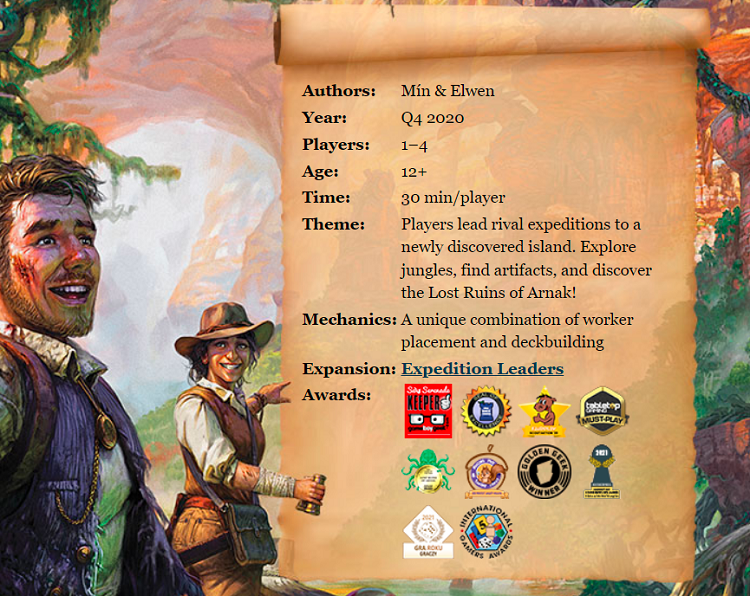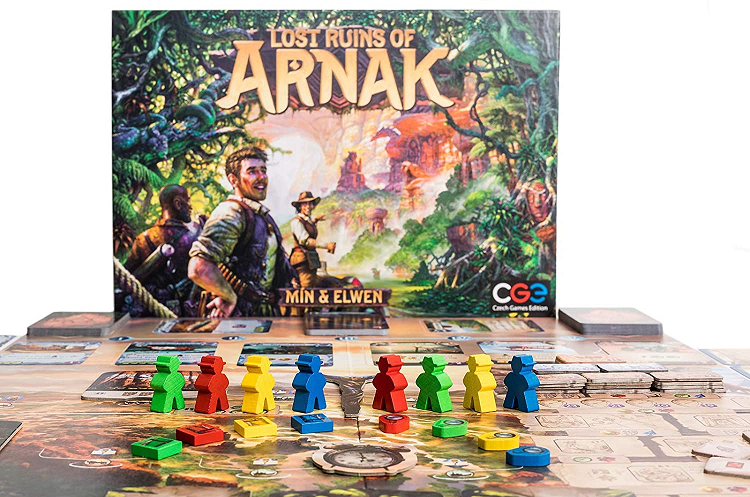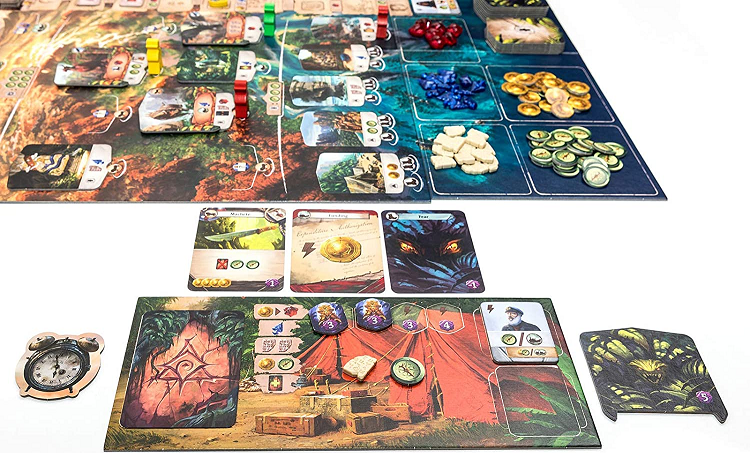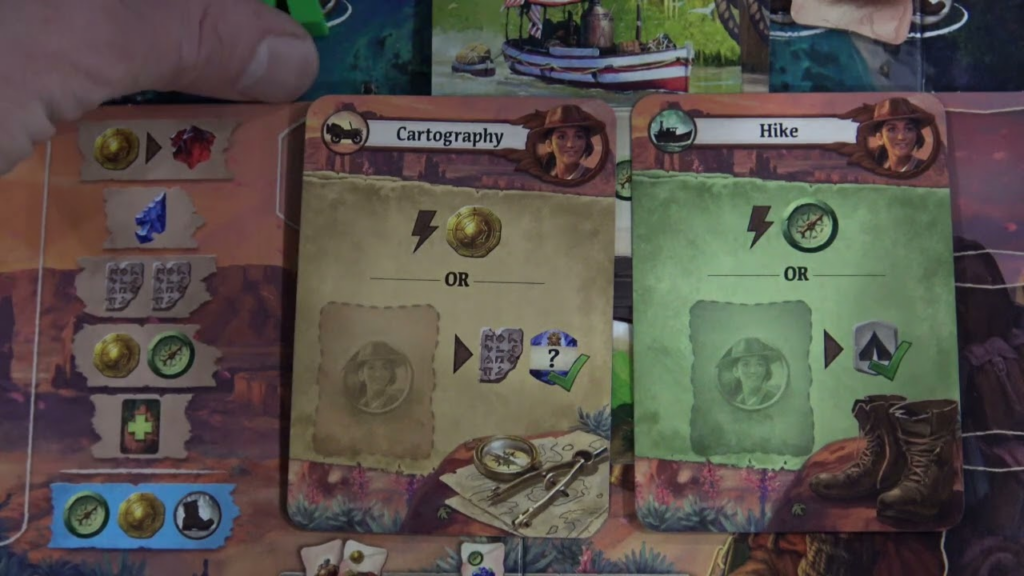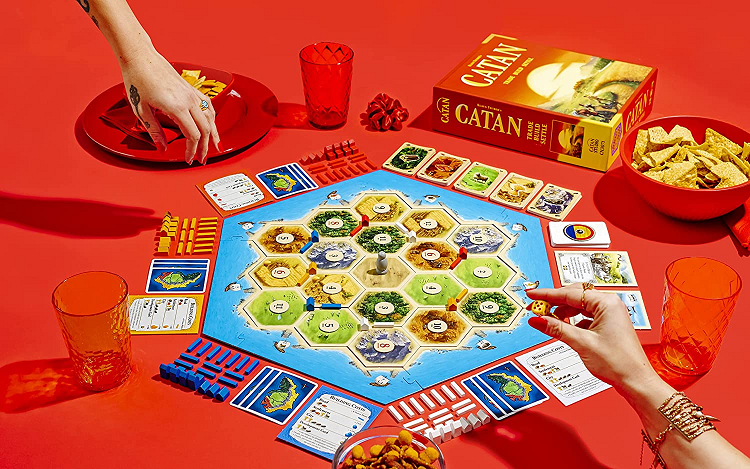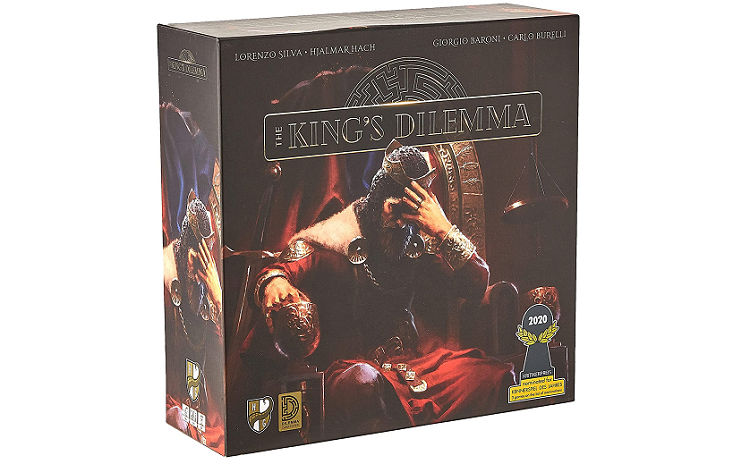Ready for the adventure of a lifetime? In Lost Ruins of Arnak, you can travel, explore, discover, and build…all from the comfort of your own home.
Uninhabited islands have captured the imagination of civilizations past and present, with a wide array of novels, TV shows, and movies emerging.
In particular, fans of the 2004 TV series Lost will find Lost Ruins of Arnak a welcome addition to their arsenal of games since the two share a reasonably similar premise.
Lead an expedition to explore the island, uncover ancient artifacts, and face fierce guardians as you attempt to uncover the secrets of the mysterious land in this deck-building and worker placement game.
There’s just one question: can you use your turns effectively to continue learning more about the island, or will the rival expedition group discover the lost ruins before you?
To learn more, keep reading this comprehensive Lost Ruins of Arnak guide.
Lost Ruins of Arnak: an Overview
Lost Ruins of Arnak is a deck-building adventure game that was released in 2020 by Czech Games Edition. In fact, it ended up being one of the hottest games that year!
According to the dynamic duo Min and Elwen, who are credited with designing the game (and have also been married for several years), Lost Ruins of Arnak takes heavy inspiration from Jules Verne and Indiana Jones.
The couple was also inspired by their favorite games, Ascension and Lords of Waterdeep. Still, they wanted to create something new that combined two very different game structures: deck building and worker placement.
Though Min and Elwen encountered numerous obstacles when they tried to make these two mechanisms work together harmoniously, they ultimately succeeded by opting for what they call “micro turns,” – meaning each player is limited to one action per turn.
The result of this experiment is a highly accomplished game that has had a profound impact on the industry. Notably, Lost Ruins of Arnak won Medium Game of the Year at the 15th annual Golden Geek Awards and was also runner up for Best Artwork Presentation.
There are hundreds of different strategies to choose from when it comes to exploring Arnak, from carrying out research to finding resources and mapping out various temples. It’s entirely up to you how you choose to approach the game, which is one of the best things about it, in my opinion.
The History of Arnak
One of the things that makes Lost Ruins of Arnak such a special game is the level of thought and detail that went into its design. The harder you look, the more there is to find, with plenty of backstory being provided by the artists and designers.
Before the concept of Arnak became a real game, Min created a detailed document titled “The History of Arnak,” in which she began setting out a detailed history for the fictional island.
Likewise, artist Ondrej Hrdina created beautiful sketches depicting scenes from Arnak’s past. Together, they created a rich tapestry of culture, which defined their understanding of the island as they set to work on the actual board game.
In one interview, Min recalls the sheer level of detail they went into, describing the island’s unique geography; its climate; its flora and fauna; the people who used to inhabit it; their myths; their lifestyles; and their beliefs.
The hard work that went into creating Arnak is reflected clearly in the game’s design.
Design of the Game
Lost Ruins of Arnak cultivates a very clear adventure aesthetic that feels reminiscent of Indiana Jones.
The earthy, muted colors of the board and its components reflect the history of the island; it’s clear that there are ancient secrets afoot, and the design of the instruction booklet, which looks like an antique leather-bound journal complete with sepia photographs and handwritten notes, reinforces the mysterious atmosphere of the game.
In contrast, the supply board and player boards are vibrant, showing off the island’s resources if only one looks closely enough.
If you like the well-thought-out design of Lost Ruins of Arnak, I’d also recommend King’s Dilemma and Sleeping Gods.
The Aim of the Game
As expedition leader, you must lead your fellow explorers across the island of Arnak with the hope of uncovering secrets from ancient civilizations.
As you progress, you can carry out many different tasks, such as equipping your expedition and uncovering important archaeological sites from ancient civilizations. Still, your ultimate aim is to discover the lost temple of Arnak.
Each accomplishment you make earns you points; these points are added up at the end of the game to determine the winner.
How to Play Lost Ruins of Arnak
Are you ready to venture across the dense jungles and golden sands of Arnak? Here’s how to play!
Setup
First of all, each player should select a color and take the following pieces that match that color:
- Player board – place in front of you and put your archaeologist figures on it
- Research tokens – place on a starting space below the research track
- Two archaeologist figures – these should be near the tents
- Four basic cards
Starting Deck
Each player has a starting deck; each deck is the same, to begin with, containing:
- 2x funding cards
- 2x exploration cards
- 2x fear cards
Start by shuffling your deck and placing it face down on your player board.
Play Order
The player who most recently traveled to a place they have never been before should start the game. Give them the starting player marker – play then continues clockwise.
Gameplay
The game consists of five rounds in total. Each turn, players choose what action they want to pursue; as the game progresses, more of the island will be explored and subsequently revealed.
A round goes like this:
- Each player draws a hand of five cards from their decks.
- One main action can be carried out per turn and an unlimited number of free actions.
- You can pass when it’s your turn to indicate you have finished playing for the remainder of the round. Players continue taking turns until everyone has passed.
- Next, it’s time to set up for the next round. Shuffle all cards and return them to the bottom of your deck.
- At the end of each round, move the moon staff to mark the passage of time. The moon continues to wax as the expeditions explore the island; after five rounds, it is full, and it’s time to see who was most successful.
You can choose one of the following actions when it’s your turn.
Dig at a site – pay the travel cost that’s written on the space where you want to send your archaeologist, then resolve the effect depicted at the site.
Discover a new site – pay the depicted cost on the site you want to travel to, take the idol, discover the site (take the top tile from the matching stack and place it face up), then awaken the guardian by drawing the top tile from the guardian stack.
Overcome a guardian – you need to already have an archaeologist on the guardian’s site. To overcome them, pay the cost depicted on the tile and remove the guardian from the board.
Buy a card – choose whether to buy a card or artifact. In both instances, you have to pay the price indicated on the card, either putting the item face down at the bottom of your deck (in the case of a card) or moving the artifact to your play area.
Play a card – play the card face-up from your hand, resolving its effect and leaving it in your play area for the remainder of the round.
Research – decide which research token to move. It’s important to be aware that your notebook must never move to a row above your magnifying glass. Choose a space to move into that is connected to your current space and pay the cost before gaining the results of your research.
Pass – when it’s your turn, you can choose to pass, which counts as the main action of your turn. If you take no other main action you have to pass, you get no more turns for the remainder of the round.
Exile
Specific rules can send cards into exile, which can be found at the top of the main board. Besides fear cards, exiled cards don’t usually come back into play.
The Lost Temple
When your magnifying glass reaches the top row of the research track, you have finally discovered the Lost Temple! Of course, the sooner you reach this point, the more points you earn.
Place your magnifying glass on the final empty space, worth the most points. After this, take a bonus tile of your own choosing.
You can now use later research actions to discover the stories of Arnak!
Assistants
Assistants are people who are involved in your expedition. Each assistant has two levels: silver and gold. As you might have guessed, the latter has the stronger effect. The research track will provide you with silver assistants when you move your notebook token to specific rows.
You should move it sideways; this shows that the assistant is exhausted and not available. Generally, assistants have one effect, which can be used only once per round.
Setting up the Next Round
All players should do the following:
- Return both archaeologists to the player board, adding one fear card to your play area each time you take back an archaeologist from a site with a guardian
- If you have cards left, each one can be discarded to your play area
- Gather and shuffle all cards in your play area and put them face down at the bottom of your deck
- Refresh your assistants
- Adjust the card row, exiling the two cards on either side of the moon staff and moving the moon staff to the right before refilling the card row
End of Round 5
At the end of the final round, all players take back their archaeologists and gain fear from the guardians. Then, proceed to the final scoring; whoever has the most points wins.
Who is Lost Ruins of Arnak For?
Lost Ruins of Arnak is recommended for one to four players aged twelve and above.
The game itself is quite complex, with lots of different rules and scoring methods to be aware of, so this age range is appropriate, in my opinion.
I wouldn’t necessarily call it a family game because it takes quite a long time to get to grips with how to play. Still, it definitely has the scope to appeal to a wide range of board game enthusiasts, particularly those who enjoy the adventure genre.
How Many Pieces are There in Lost Ruins of Arnak?
Here are all the components included in the game:
- 1x main board
- 4x double-sided player boards
- 1x double-sided supply board
- 4x basic cards in each color
- 19x fear cards
- 40x item cards
- 35x artifact cards
- 1x pad of scoring sheets
- 1x starting player marker
- 1x moon staff
- 12x assistant tiles
- 6x level site tiles
- 10x level site tiles
- 15x guardian tiles
- 27x coin tokens
- 27x compass tokens
- 16x idol tiles
- 24x temple tiles
- 1x sticker sheet
- 1x notebook token in each color
- 1x magnifying glass token in each color
- 16x tablet tokens
- 12x arrowhead tokens
- 9x jewel tokens
- 5x blocking tiles
- 15x rival action tiles
- 10x reserve tiles
- 18x research bonus tiles
- 2x archaeologist figures in each color
Alternatives to Lost Ruins of Arnak
Here are some other games I’d recommend trying if you like the sound of Lost Ruins of Arnak.
Catan
Settlers of Catan is arguably one of the most successful board games of all time, with more than 30 million copies sold worldwide. Like Arnak, it involves settling on an island. Still, instead of gathering ancient secrets, the aim is to build a thriving civilization.
Want to know more? Read our Catan Board Game Guide.
- Players – 3-4
- Recommended age – 10+
- Playing time – 60 minutes
King’s Dilemma
If you love the level of thought and detail that has gone into creating Lost Ruins of Arnak, I guarantee you’ll enjoy King’s Dilemma. In this legacy board game, the aim is to influence the decisions of the King to bring about your own agenda. Like Arnak, worldbuilding is astounding.
We have a King’s Dilemma Game Guide covering all the information you need.
- Players – 3-5
- Recommended age – 14+
- Playing time – 60 minutes per round
Lost Ruins of Arnak – is it Worth Buying?
Lost Ruins of Arnak doesn’t necessarily bring anything new to the adventure genre – other than its creative inclusion of deck building and worker placement mechanisms – and this has led to the game being overlooked by some members of the gaming community.
In my opinion, this is a huge shame because the sheer amount of creativity poured into the game’s design and the story is astounding.
There is something very special and totally unique about Lost Ruins of Arnak. The game is gripping – even if the gameplay can be a little tough to get your head around – and despite the slightly unoriginal premise, I’d go as far as to claim that no other board game has managed to execute this idea so successfully.
Would I recommend Lost Ruins of Arnak? Absolutely.
Frequently Asked Questions
Question: What is a Deck-Building Game?
Answer: A deck-building game refers to any card or board game where you build your deck as you play, and each player has his or her own deck.
Question: What is a Worker Placement Game?
Answer: In this type of game, each player has a team of workers who they can deploy to carry out different actions.
Question: Can I Have More than Five Cards in my Hand?
Answer: The hand limit only applies when you first draw your cards, so it’s entirely possible for you to end up with more cards throughout the game.
Question: Am I Allowed to Shuffle my Deck During the Game?
Answer: This isn’t allowed; you can only shuffle your deck when you start the game.
Question:Is Lost Ruins of Arnak a Family Game?
Answer: I’d say it depends on the age of your family; there are a lot of rules to follow, and it can take a while to get to grips with the game at first, so I’d recommend the game to families with older kids and those who have a lot of time for playing.
We also have a guide that will help you find the best family board games.
Recommended reads:
- Stratego Pieces Explained – Must-Know Facts - February 28, 2023
- Wahoo Board Game Guide – AKA Aggravation Guide - February 22, 2023
- Pokemon Monopoly Guide - February 22, 2023


